To view the presentation slide show, click here
I recently presented to a group of aspiring young leaders. I spoke about emerging dynamism within an organization as an outgrowth of regulating the relationship between rules and values. From the feedback I received, I believe this is an important and relevant topic. Following is a brief summary of the presentation:
My journey of discovery regarding the relationship between rules and values began after I attended two presentations that appeared to be contradictory. In the first, the presenter made a compelling case that our organizations should run from ‘templates,’ where our employee’s behaviors are heavily scripted. In his view we derive ‘benefit’ from a rules-centric culture. He asserted that this culture provides ‘consistency of performance to better serve the customers and the brand.’ In this view, consistency of performance is endemic to a strong brand – hence scripting, directives, rules, and mandates drive brand perception. This presenter cited several examples of premium, strong brands that operate this way. These brands were noted for exceptional customer service.
The second presenter argued for a ‘free’ workplace, where employees are allowed ‘to be themselves.’ This presenter effectively made the case that when employees have the freedom to be themselves in the workplace, there is more and better engagement – and that engagement is essential to functionality and dynamism. Further, he and a colleague validated their position through a research project that demonstrated a link between ‘individuality’ and engagement in the workplace. When employees felt they could ‘be themselves’ in the workplace, the workplace became more engaged and dynamic. As was the case with the first presenter, this second presenter was convincing.
My contemplation regarding these two opposed positions started about five years before the acquisition of my company. The journey through a resolution of the two assertions was instructive and served the company well. In my presentation, I spoke about this journey and its outcome.
The question we sought to answer was ‘how do we achieve dynamism in our organizations while at the same time mitigating the risk of chaos?’ For me, the emerging answer, over time, is that we do this by regulating or managing the relationship between rules and values. In our company, it was moving the organization from a ‘rules-centric’ to a ‘values-centric’ culture. However, we also learned that this is a complex task that we best achieve as a self-organizing emergence based on smaller strategic initiatives – rather than a directly imposed strategy.
Three Balance Sheets
Through this process, I began to view the organization as having three balance sheets. We, of course, have our financial balance sheet – assets on the left side and liabilities on the right, with the difference being financial equity (this is an oversimplification, not considering retained earnings and distributions). As an academic exercise, I also envisioned an operational balance sheet with continuous improvement, statistical measures, and KPI development on the left side – and goals, quotas, and mandates on the right. These are not measurable or quantifiable. But the point is that the more we can displace goals, quotas, and mandates with continuous improvement, statistical measures, and KPI development, the more operational equity we build in our organizations.
And finally, there is the cultural balance sheet. Here, we put values and principles on the left side and ‘non-core’ rules on the right. We define non-core rules as inter-connected with values, i.e., scripting, instruction, directives, and mandates. This set of rules is opposed to core rules, which are independent of values – and need always to be present. On this balance sheet, we say that the more we can replace non-core rules with values and principles, the more cultural equity we build. Again, these are not measurable or quantifiable – it is the concept that matters.
We based the model for dynamism on the cultural balance sheet – and the idea that we build cultural equity as we transition away from non-core rules and move toward development of a values construct.
The Construct
When thinking about the contradictory presentations, a graphic came to mind. On one side – visualize left- we have rules on top and order at the bottom. The opposite side – imagine right – has ‘no rules’ on top and chaos at the bottom. Where we have rules and order on the left, we also have conformity and restraint. Here, we will also have stagnation. Then we put a cliff into the construct. This cliff runs from left to right, with a precipice about three-quarters of the way across the graphic. As we start to relax our non-core rules by reducing scripting, instruction, directives, and mandates, the emerging individuality moves us across the top of the cliff toward the precipice. As we move toward the precipice, we experience a blossoming of individuality and creativity. Continuing to move from left to right, we witness improvements in engagement and morale. And when we get right to the precipice – at the edge of chaos – we are at the heart of dynamism. However, the edge of chaos is also the most dangerous place for an organization – just a step away from a descent into chaos. The descent into chaos is where our organizations unravel.
We know this intuitively, so we tend to stay far away from the precipice. We stay all the way to the left side of the construct, where we feel safe. There, we are comforted by rules and order. The problem with being where it feels safe is that we sacrifice dynamism. In today’s highly iterative, ultra-fast-paced business climate, a dearth of dynamism can be a slow death (instead of the quick demise from a descent into chaos) – but a death nonetheless.
The question becomes, how can we move toward the edge of chaos without descending into it? What can provide a safety net at the precipice?
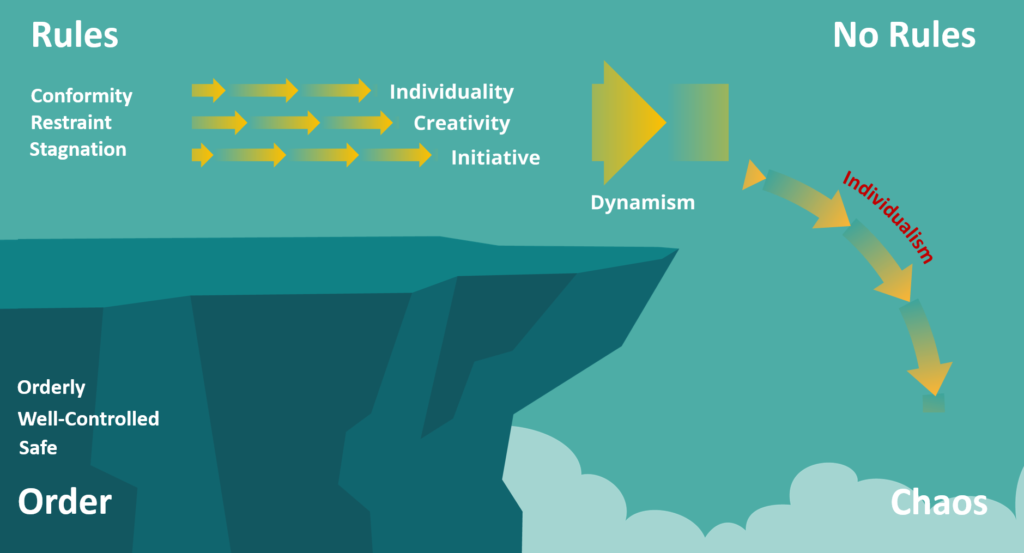
Dynamic Leadership
From time to time, we see companies that have ‘genius’ leaders who can bring their organizations to the edge of chaos – and hold them there. These are typically highly charismatic leaders that can energize their organizations through a management style that eschews the rules of a structured hierarchy. They are leaders who are fanatically passionate about their products or missions. As examples, I put Steve Jobs and Elon Musk in this group. I also worked for this type of leader after my first company was acquired. So, I had a chance to see this style of leadership working up close. These leaders can push toward the precipice and then push back at the edge at the same time. They are firmly in charge.
In this ‘leadership’ iteration of the construct, we replace the vacuum of ‘no rules’ (in the upper right-hand corner) with ‘leadership.’ It is a highly effective way to bring an organization from stagnation to dynamism quickly. It can disproportionately have value in jump-starting immature companies. But it also has problems.
The first problem is that these leaders are highly gifted, and they are few and far between. They are typically brilliant and possess a gift – a genius – for this type of leadership. Few organizational leaders can achieve this result. The second problem is that the dynamism lasts only as long as the leader is there and is effective. These ‘dynamic’ leaders will sometimes have egos that preclude servant leadership. They have difficulty subordinating themselves to their organizations. They fail to insulate their organizations from dependency on them. While this may be a compelling dynamism, it is not a durable dynamism.
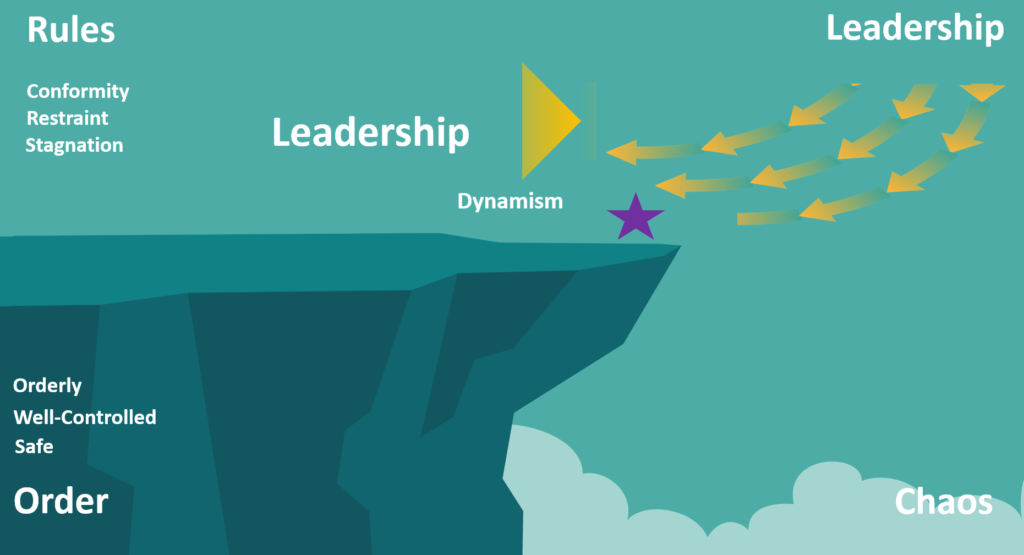
Values
In my presentation, I make the case that instead of leadership, it should be ‘values’ that fill the void of ‘no rules.’ As we allow for a blossoming of creativity, developing an effective values construct is the proper safety net to prevent a descent into chaos. We allow for this blossoming through the encouragement of individuality by deliberately relaxing non-core rules. The more effectively we develop and communicate our values, the closer we can get to the edge of the precipice. I suggest a mantra regarding the relationship between rules and values: ‘Rules only as necessary and values everywhere possible.’
By filling the void with values, we achieve a durable dynamism – rather than the fragile and transient dynamism we achieve through a direct application of leadership. However, the leader does have a critical role in this construct. The leader’s role is to move the organization from rules to values as the organization matures. The challenge for the organization is knowing where rules are necessary while at the same time instilling values everywhere.

Emergent Self-Organization
To understand what is happening across the top of the cliff – as we move toward dynamism, we can look at a 2015 study cited in the journal ‘Frontiers in Psychology.’ In this study, researchers asked a trio of jazz musicians to improvise a piece of music. As this was pure improvisation, as expected, the early returns were disorganized and chaotic – amounting to nothing more than incoherent noise. But, over time, without sheet music or any guidance, the noise began to organize into music. Eventually, the trio improvised a beautiful piece of jazz music. Frontiers in Psychology reported it this way: “…over time their actions became so tightly coordinated and their decisions so seamlessly intertwined that the trio behaved as a single synergistic system rather than a collection of individuals.” Imagine if our organizations were a single synergistic system rather than a collection of individuals. Or stated better, a group of ‘individuals’ that function as a single synergistic system. This function is the outcome of a process called ’emergent self-organization.’
In this process – and most importantly, the disparate chaotic noise only self-organizes into beautiful music if each trio member shares the value for beautiful jazz music. Otherwise, it remains chaotic noise. This same organizing occurs for large orchestras. Classical musicians are put together in a room with no sheet music and no orchestra conductor. Over time, their disparate sounds self-organize into beautiful music. But only if the members of the orchestra share the value for beautiful classical music. Worth noting is that the more the value is shared, the more efficiently the music organizes. The larger the group, the slower the process.
As with music, as we encourage individuality in our organizations and move toward the precipice where dynamism lives (and chaos lurks), we can only have the emergence of self-organization to the extent that the organization shares a set of strong and deeply embedded values. The more effectively these values are discovered and cascaded across the organization, the closer we get to the precipice – where the heart of dynamism is.
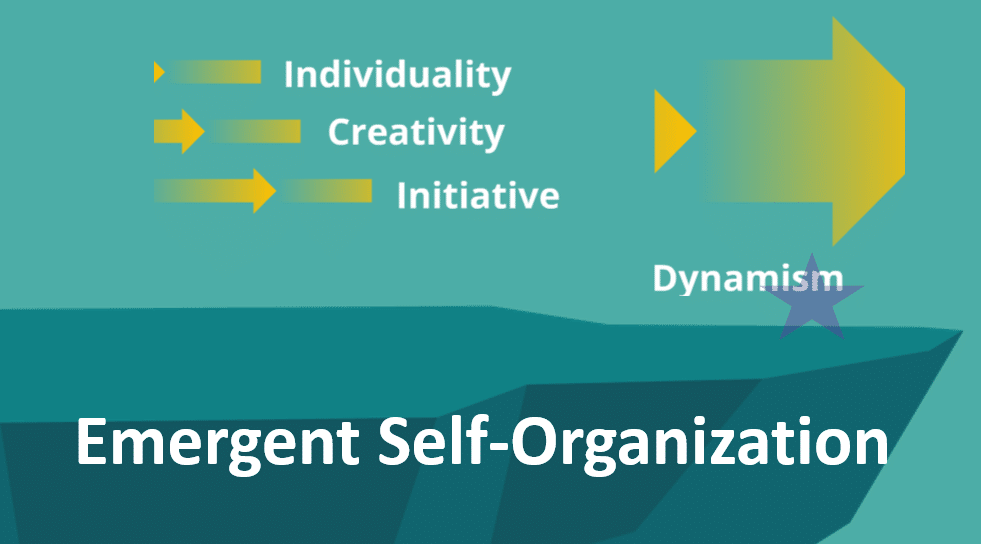
Individuality and Individualism
As we encourage our employees to be themselves, we prevent individuality from morphing into individualism by coalescing around a set of values. This morphing of individuality into individualism is the primary mechanism by which our organizations move past the precipice and descend into chaos. Individuality is what we want to foster in our organizations. It is how we move toward dynamism and away from stagnation. Individuality allows our employees to be themselves in the workplace – they will be more engaged. However, suppose we foster individuality in the workplace without a fully developed and effectively cascaded set of values. In that case, we are likely to see the emergent toxicity of individualism in at least some places.
With ‘individuality,’ we are allowing our employees to be themselves to the benefit of the group. Conversely, with ‘individualism,’ these same individuals work at the expense of the group. With individuality, individual interests remain subordinated to the group’s best interest – the individual has freedom of expression but is committed to serving the group. Conversely, with individualism, the individual subordinates the group’s best interest to personal interests – the emergence of ego sabotages service and subordination. It is not difficult to make this distinction and to see that a dearth of values would lend itself to this unfortunate progression. All we have to do is leave a vacuum where we should have discovered or developed values, for this toxic progression to occur.
Developing and Applying Values
For the development, discovery, and communication of values, we utilized the work of Patrick Lencioni and his book ‘The Advantage.’ In this model there are four types of values. The most important is ‘Core Values.’ The other values are ‘Aspirational,’ ‘Permission to Play,’ and ‘Accidental.’
Core Values are distinctive, demanded, and unchanging. We always have them, so their emergence into the company narrative is a process of discovery rather than of development. This process of discovery can be arduous and lengthy. It requires a highly functional leadership team whose members have high levels of trust in each other. There must be ‘healthy’ – never ‘unhealthy’ conflict. The difference between healthy and unhealthy conflict brings us back to the difference between individuality and individualism.
Individuality contributes to healthy conflict, where individualism precludes it. The difficulty is that we need healthy conflict to discover core values. At the same time, we need core values to prevent the emergence of individualism. The preclusion of individualism is necessary for healthy conflict. So, to start the process toward the functionality of the leadership team, we did personality assessments to help the team members better understand each other. We also took the team through a series of transparency and vulnerability exercises. An outside facilitator from ‘The Table Group’ (Patrick Lencioni’s consultancy) provided guidance. Through this process, healthy conflict emerged. This healthy conflict is then sustained going forward, enabled by the discovery and cascading of values.
In taking the leadership team through this process, there is the chance that individual team members will reveal themselves as incompatible with the initiatives for building trust and cohesiveness. As a result, these members may exit themselves. If they fail to do so, they may have to be removed from the team.
Once we establish functionality for the leadership team, the discovery process can begin. With guidance from The Table Group, we entered the discovery process by asking ourselves the question, ‘Why do we exist?’ The answer to this question is our ‘Core Purpose.’ If addressed correctly, it is a difficult question to answer. It can only be effectively answered as an outgrowth of functionality, trust, and cohesiveness. It may take weeks or months of deliberation to discover an organization’s Core Purpose.
With the discovery of the Core Purpose, we could then go to work discovering our Core Values. We defined our Core Values as ‘the behavioral manifestation of the Core Purpose.’ They answer the question ‘How do we behave?’ The discovery process will reveal only two or three Core Values. More than this number would belie the requirement for permanence and distinctiveness. Core Values are the values that are the essence of the business.
Aspirational Values are as titled – these are the values we aspire to but are not core to the business. We can have any number of these. And Permission to Play Values are where we set the bar – or the minimum standards to qualify for employment. But, again, these will differ from Core Values, primarily in that they tend to be ubiquitous rather than distinctive.

Accidental Values are as named – values that come into our organizations accidentally. These can be positive, but in reality, they tend to be negative. A positive Accidental Value will likely become an Aspirational Value or a Permission to Play Value (they can never be Core Values). Accidental values are often brought into our organizations by individual members – and may be disruptive to – or inconsistent with the existing values construct.
Accidental Values will often fill the vacuum created by a failure to develop an effective values construct. This vacuum will be a magnet for the Accidental Values we don’t want. These Accidental Values will result from and contribute to the morphing of individuality to individualism and take our companies over the precipice into chaos – as we try to encourage individuality. They preclude the coalescing around the desired values that are necessary for the emergent process across the top of the cliff.
After discovering why we exist and how we behave, we went to work to effectively communicate our core purpose and core values across the organization. To do this, we once again turned to the work of Patrick Lencioni, and we created a Playbook. The Playbook is a single sheet of paper that answers five questions. The first answer provides the Core Purpose – why we exist. The second answer produces the Core Values – how we behave (or the behavioral manifestation of the core purpose). The Playbook sat on every manager’s desk. It was laminated to the top of the Leadership Team members’ laptop computers. It was present in every team meeting. We invoked it both proactively and responsively, fostering a cascading of the values throughout the organization. Through this process, organizational values became indelibly woven into the daily company narrative.
Developing and Applying Rules
Understanding the development and application of rules within this construct requires first separating rules into two types: Core (fixed) and Non-core (variable). We define Core Rules as those that exist independent of values. These are the rules you must have in your organization, regardless of values or a values construct. They are non-discretionary. Core Rules will generally address behaviors regarding legal, compliance, and the health, safety, and well-being of employees. They are present in a human resources handbook. They validate the importance of highly skilled and accomplished leaders in areas of Human Resources and Compliance. Like with Core Values, leaders must effectively communicate Core Rules across entire organizations.
We define Non-core Rules as rules we interconnect with values. These are the rules that are ‘in play’ in our rules and values construct. They generally regard scripting, instruction, directives, and mandates. As identified in this presentation’s premise, our objective is to have these rules only as necessary while at the same time having values everywhere possible. Our challenge is knowing where non-core rules are necessary and everywhere values are possible.
(The following section is academic and omitted from the presentation. It is available for discussion based on inquiry)
A strategic application of Non-core Rules in the construct is complicated and, at the same time, unnecessary. It is theoretical and academic. It is therefore omitted from the presentation. I provide support materials and I make myself available for the ‘academic’ discussion, if there are inquiries. The needlessness of a strategic application is because effectively discovering and cascading our values and efficiently building out a values construct will set into motion a self-organizing and emergent application of Non-core Rules. This application of Non-core Rules will emerge with an efficiency proportionate to the effectiveness of the values construct. This effectiveness is dependent on the discovery of the core values and their cascading through the organization. So, with a strategic focus on the values construct, the Non-core Rules application will emerge as a default process.
Therefore, in making the presentation, I encourage avoiding a strategic application of Non-core Rules. The application should be viewed as an emergent process that will happen with an efficiency moving toward ‘only as necessary.’ This efficiency is proportionate to the effectiveness of the development of the values construct. Yes, this is complex – but it does not need to be understood to be emergent in this way. The graphic below demonstrates the default position for the application of rules through emergence – as a default process. I caution, in my presentation, that to try to achieve this outcome strategically would require us to label our employees as ‘conceptual/abstract’ or ‘symbolic/verbal’ processors. This labeling is something we should avoid doing. Few of us as leaders are likely to have this skill (unless we are perhaps psychoanalysts), and to try to do so is dangerous and potentially immoral.
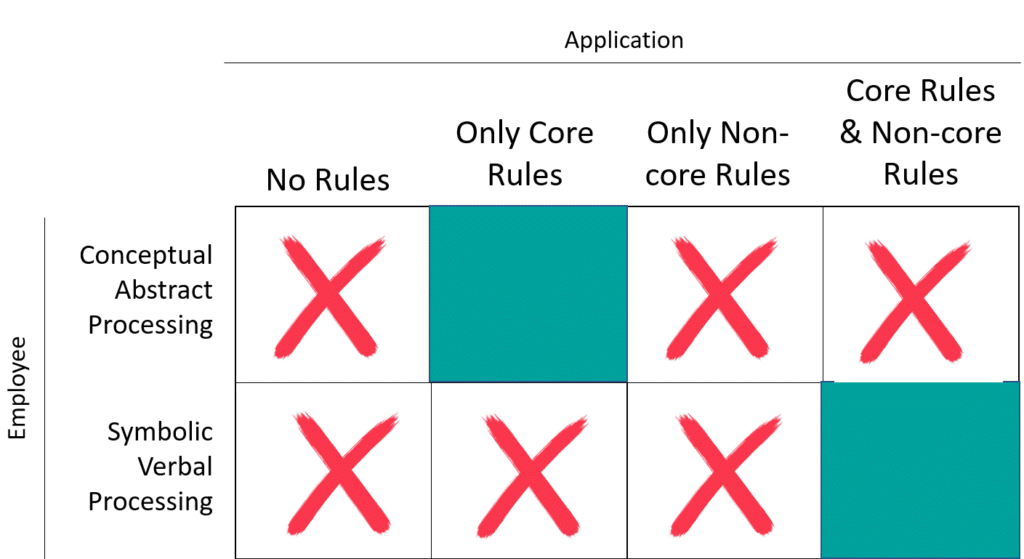
(The impetus for this design is from the work of Sam Glucksberg and from Elliott Jaques. Each red X represents either a violation of the requirement for Core Rules or for an unacceptable outcome. The emergent default process leaves only the green boxes as the viable application for Non-core Rules in the larger construct. Because this is theoretical and academic, I provide these materials separately, as a handout and do not include this concept in the narrative of the presentation).
The application of rules – recommended as an emergent rather than a strategic process completes our grid for the development and application of rules and values. The completed grid is as follows:
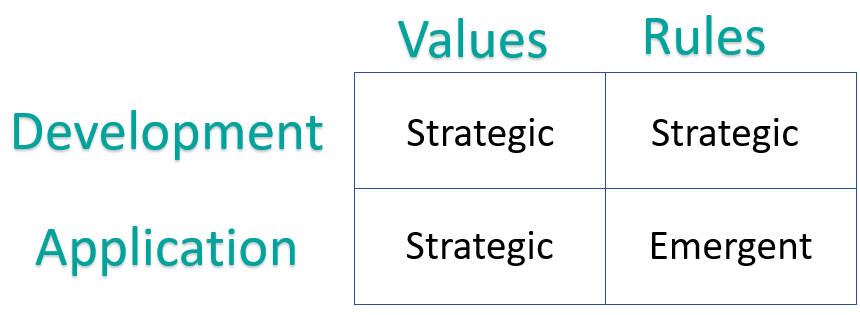
Emergence and Strategy
Peter Drucker famously said that ‘culture eats strategy for breakfast.’ For me, it follows that ‘Emergence provides for an authenticity that belies and transcends strategy.’ The extent to which culture contributes to emergence may be a consideration in Mr. Drucker’s assertion. In my organization, I sometimes advocated for ’emergent self-organization’ instead of ‘strategic initiative.’ There is a connection between emergence and authenticity – and then between authenticity and durability. This connection is perhaps why companies, systems, and processes that develop slowly tend to be more durable. Jim Collins recognized the relationship between slower development and durability in his book ‘Good to Great.’
Within the rules and values construct, the relationship between strategy and emergence is complex – but vital to the organization’s move to the heart of dynamism. Strategic initiatives are necessary for emergence to occur. Within the larger construct, the development of the values system that includes the discovery of values and their communication across the organization is a strategic endeavor that enables the emergent self-organizing process of moving across the cliff toward dynamism – without descending into chaos. As displayed in the grid of our rules and values development and application, development of rules and values – and the application of those values are strategic. At the same time, the application of Non-core Rules is emergent. In both places – the top of the cliff and the rules/ values grid, the efficiency and quality of this emergence will be proportionate to the effectiveness of the employed strategies. These strategies are the building of the values construct and the development of Core Rules.
Additionally, we recognize that emergence is a slow process – and at times, it may be too slow. The appropriateness of the process is dependent on the organization’s maturity. When the process is too slow, we can use strategy as a bridge for acceleration while emergence evolves, or as an organization matures.
Summary of the Steps to Dynamism

The Beginnings of Things
Cicero famously said, “the beginnings of all things are small.” Similarly, the beginnings of meaningful change start with a shift in perspective. My purpose in making this presentation is the hope we can better open our minds to new possibilities in running our companies – to bring a new or enhanced perspective to our organizations that will, over time, facilitate an emerging journey toward the heart of dynamism.
